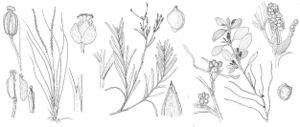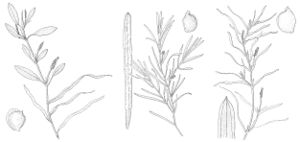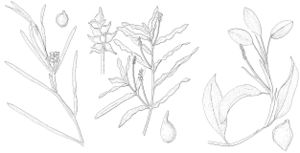Potamogeton
Sp. Pl. 1: 126. 1753; Gen. Pl. ed. 5; 61, 1754.
Herbs: rhizomes present or absent; tubers absent; turions present or absent. Stems terete or compressed, nodes occasionally with oil-glands; turions with extremely shortened internodes, divided into outer and inner leaves; outer leaves 1–5 per side, similar to vegetative leaves or occasionally corrugate near base; inner leaves 1–10, rolled into fusiform structure, unmodified, or shortened and oriented at 90° angles to outer leaves. Leaves submersed or both submersed and floating, alternate to nearly opposite; stipules connate or not, if not, then convolute, tubular, sheathing stem and young inflorescences. Submersed leaves sessile or petiolate; stipules either free from or adnate to base of leaf-blade for less than ½ length of stipule, if adnate, then extending past adnation as free ligule; blade translucent, linear to orbiculate, not channeled, flattened, base acute to perfoliate, margins entire or serrate, rarely crispate, apex subulate to obtuse; veins 1–35. Floating leaves petiolate, rarely nearly sessile; stipules free from base of leaf-blade; blade elliptic to ovate, leathery, base cuneate to rounded or cordate, margins entire, apex acute to obtuse; veins 1–51. Inflorescences spikes or panicles of spikes, submersed or emersed, capitate or cylindric; peduncles stiff, if long enough then projecting inflorescence above surface of water. Flowers: pistils 1 or 4. Fruits abaxially rounded or keeled, flattened to turgid, beaked; embryo coiled 1 or more times. x = 13 or 14.
Distribution
Nearly worldwide
Discussion
Potamogeton is one of the most important genera in the aquatic environment, especially as food or habitat for aquatic animals (R. R. Haynes 1975). A few species become slightly weedy, but not significantly so. Plants of Potamogeton are important in stabilizing substrates and removing particulate matter from the water column.
The genus has been divided into several sections and numerous subsections (predominantly by J. O. Hagström 1916; see also R. R. Haynes 1975, 1985 for in-depth coverage of three subsections). After studying thousands of specimens over at least five continents, we believe that recognition of the many infrageneric categories is unwarranted. Consequently, we are not including infrageneric classification here.
Hybridization is common among members of the genus (J. O. Hagström 1916). Numerous hybrids were proposed, using intermediate stem anatomy as evidence of hybrid origin. We list all the hybrids that Hagström proposed for species that occur in North America. An additional 26 hybrids have been recognized for the British Isles (C. D. Preston 1995).
Vegetative and reproductive morphology varies considerably in the genus. Two types of stems occur, rhizomes and erect stems. Some species have both, others have only erect stems. Two types of leaves exist, submersed and floating. Floating leaves have well-developed epidermis abaxially and adaxially, and well-developed cuticle at least adaxially. Floating leaves may be similar in shape to that of the submersed, or they may differ considerably. Submersed leaves have no cuticle and do not have well-developed epidermis. All species of Potamogeton have submersed leaves; some also have floating leaves. Occasionally, individuals of floating-leaved species lose their submersed leaves because of decay or wave action. Leaves of Potamogeton may be sessile or petiolate and are divided into at least blade and stipule. The stipule may be adnate to the blade for 1/3 or less the length of the stipule. Venation in the stipule is parallel, and veins may appear coarse as distinct ridges on the stipule (fibrous), or they may be much less obvious, even difficult to observe (delicate). Stipular tissue between veins of fibrous stipules decays, leaving strands of fibers, whereas veins and the tissue between them decay in delicate stipules.
Many species have oil glands on the stem at the node of submersed leaves. These glands are especially common on species with sessile leaves. Circular and ranging from green to golden to white, they are present at most nodes, sometimes at all, or possibly only occasionally present. The glands (or nodal glands) are best observed with dried specimenses, a good light source, and magnification of at least 15´, although they can be observed under less ideal conditions.
Inflorescences may be either emergent or submersed. Emergent inflorescences are elongate and almost always terminal on the stem, whereas submersed inflorescences are globular and axillary. Most species have either emergent inflorescences or submersed inflorescences, but not both (monomorphic). Other species have both types of inflorescences on one plant (dimorphic).
All specimens should be collected when in fruit. Fruiting characteristics are extremely important in the genus, although they are not always given in the key. Vegetative features during fruiting are distinctive for the species; consequently, they are included in the key. Important features of the fruit include presence or absence of lateral and abaxial wings, ribs, ridges, or keels. Here, "ribbed" indicates a raised "vein" on a rounded surface; "ridged,"; a ridge with an obtuse angle; "keeled," a ridge with an acute angle; and "winged," a ridge that appears to have a wing distally.
Species ca. 100 (33 in the flora).
Selected References
Lower Taxa
Key
| 1 | Stipular sheaths of submersed leaves adnate to base of leaf blade, tip projecting as ligule. | > 2 |
| 1 | Stipular sheaths of submersed leaves free from base of leaf blade or with only 1/–5 sheath adnate, ligule not obvious. | > 6 |
| 2 | Submersed leaves stiffish, conspicuously 2-ranked; blade lobed at junction with stipule, veins 20–60, fine. | Potamogeton robbinsii |
| 2 | Submersed leaves lax, not conspicuously 2-ranked; blade without basal lobes, veins 20 or fewer. | > 3 |
| 3 | Submersed leaf tips obtuse to acute; floating leaf tips rounded. | > 4 |
| 3 | Submersed leaf tips acute to long-tapering; floating leaf tips acute. | > 5 |
| 4 | Apex of submersed leaf blade obtuse; fruits 1.3–2.4 mm wide, lateral wings with blunt tip, beak absent. | Potamogeton spirillus |
| 4 | Apex of submersed leaf blade acute; fruits 0.9–2 mm wide, lateral wings with sharp tip, beak minute. | Potamogeton diversifolius |
| 5 | Submersed leaf blade 0.1–0.4(–0.6) mm wide, without obvious lacunae; floating leaf blade 3–7-veined. | Potamogeton bicupulatus |
| 5 | Submersed leaf blade 0.2–1(–2) mm wide, with abundant lacunae; floating leaves 9–23-veined. | Potamogeton tennesseensis |
| 6 | Submersed leaf blades broadly linear-oblong to lanceolate to elliptic or nearly orbiculate, 3–58 mm wide (occasional stranded plants without submersed leaves). | > 7 |
| 6 | Submersed leaf blade linear, threadlike, or ribbonlike, 0.1–10 mm wide. | > 18 |
| 7 | Leaf margins conspicuously serrate; stem flattened; fruit beak 2–3 mm; turions formed, hard. | Potamogeton crispus |
| 7 | Leaf margins entire; stem terete; fruit beak 1 mm or less; turions rarely formed. | > 8 |
| 8 | Submersed leaves clasping stem; floating leaves absent. | > 9 |
| 8 | Submersed leaves petiolate or sessile (not clasping); floating leaves absent or present. | > 11 |
| 9 | Leaf blade apex hoodlike, splitting when pressed; stipules persistent, conspicuous. | Potamogeton praelongus |
| 9 | Leaf blade apex flat, not splitting when pressed; stipules deciduous and/or deteriorating into fibers. | > 10 |
| 10 | Leaf blade ovate-lanceolate to narrowly lanceolate, 1.6–13 cm, veins 3–35; stipules disintegrating to persistent fibers, even on proximal portion of stem. | Potamogeton richardsonii |
| 10 | Leaf blade broadly lanceolate, orbiculate, or ovate, 0.9–7.6(–9.7) cm, veins 3–25; stipules deciduous and deteriorating, absent on proximal portion of stem. | Potamogeton perfoliatus |
| 11 | Floating leaf blade rounded to cordate at base; stem conspicuously rusty- or black-spotted; submersed leaf blades crispate, mostly arcuate. | > 12 |
| 11 | Floating leaf blade cuneate, tapering to petiole, rounded, or rarely cordate (P. oblongus); stems without spots; submersed leaf blades flat or rarely crispate (P. illinoensis), mostly not arcuate or occasionally arcuate (P. illinoensis). | > 13 |
| 12 | Submersed leaf blade with 19–49 veins; floating leaf blade with 27–49 veins. | Potamogeton amplifolius |
| 12 | Submersed leaf blade with 7–19 veins; floating leaf blade with 15–19 veins. | Potamogeton pulcher |
| 13 | Submersed leaves with petioles 0.5–13 cm. | > 14 |
| 13 | Submersed leaves sessile. | > 16 |
| 14 | Fruits (1.6–)2–2.5 mm, without well-developed abaxial keel; St. Pierre and Miquelon, Newfoundland, and Sable Island, Nova Scotia. | Potamogeton oblongus |
| 14 | Fruits 2.5–4.3 mm, with well-developed abaxial keel; widespread. | > 15 |
| 15 | Larger submersed leaves acute at apex but without sharp awl-like tip; fruits red to reddish brown. | Potamogeton nodosus |
| 15 | Larger submersed leaves acuminate at apex; fruits grayish green to olive-green. | Potamogeton illinoensis |
| 16 | Fruits plump, tawny olive-green, pedicellate; stipules blunt; submersed leaf blade 7–9-veined | Potamogeton alpinus |
| 16 | Fruits laterally compressed, greenish brown, grayish green to olive-green, sessile; stipules acute to obtuse; submersed leaf blade 3–19-veined. | > 17 |
| 17 | Fruits 1.9–2.3 ´ 1.8–2 mm; submersed leaf blade with 3–9 veins. | Potamogeton gramineus |
| 17 | Fruits 2.5–3.6 ´ 2.1–3 mm; submersed leaf blade with 7–19 veins. | Potamogeton illinoensis |
| 18 | Floating leaves often present; lacunae prominent in submersed leaves and rhizome present. | > 19 |
| 18 | Floating leaves absent or present; lacunae sometimes present but not prominent in most species, if prominent thean rhizome absent. | > 20 |
| 19 | Submersed leaves 1–3(–7)-veined; some with stipules partially adnate to leaf base; floating leaves acute at apex. | Potamogeton tennesseensis |
| 19 | Submersed leaves 3–13-veined; stipules not adnate to leaf base; floating leaves rounded at apex. | Potamogeton epihydrus |
| 20 | Floating leaves present, at least in some plants in population. | > 21 |
| 20 | Floating leaves absent from all plants in population. | > 24 |
| 21 | Floating leaf blade 0.6–1.5 cm; peduncle 0.5–3 cm; fruits 1.5–2.5 mm. | Potamogeton vaseyi |
| 21 | Floating leaf blade 1.5–12 cm; peduncle 2.5–9.5 cm; fruits if formed 2.5–5 mm. | > 22 |
| 22 | Petiole junction with leaf blade distinctly pale in color just proximal to apex; floating leaf blade ovate to oblong-ovate. | Potamogeton natans |
| 22 | Petiole junction with bladeleaf continuous in color to apex; floating leaf blade elliptic, ovate-elliptic, or oblong-elliptic. | > 23 |
| 23 | Floating leaf blades 7–12 mm wide, tapering at both ends; no fruit produced; Florida. | Potamogeton floridanus |
| 23 | Floating leaf blade 10–20(–30) mm wide, obtuse, rounded or tapering at base; fruit often produced; widespread n of Florida. | Potamogeton oakesianus |
| 24 | Rhizome obvious; peduncle (3–)5–25 cm, ascending, not recurved; leaves threadlike, 0.1–0.5 mm wide. | Potamogeton confervoides |
| 24 | Rhizomes absent or not apparent; peduncle 0.3–7 cm, erect to recurved; leaves not threadlike, 0.1–5 mm wide. | > 25 |
| 25 | Nodal glands absent. | > 26 |
| 25 | Nodal glands present on at least some nodes. | > 28 |
| 26 | Leaves 15–35-veined, greater than 2 mm wide; stem conspicuously flattened; peduncles terminal | Potamogeton zosteriformis |
| 26 | Leaves 3–5-veined, less than 2 mm wide; stem terete; peduncles axillary. | > 27 |
| 27 | Leaves bristle-tipped, occasionally apiculate to blunt, 3-veined, 0.6–2.5(–4) mm wide; fruits 3-keeled, 2.3–4 mm. | Potamogeton hillii |
| 27 | Leaves acute, 1–3(–5)-veined, 0.3–2.3 mm wide; fruits 1-keeled, 1.4–2.3(–2.7) mm. | Potamogeton foliosus |
| 28 | Stipules fibrous, often whitish. | > 29 |
| 28 | Stipules not fibrous, green, brown, or white. | > 31 |
| 29 | Leaf apex acute to apiculate; leaves 5–7(–9)-veined; turions with inner leaves at 90° angle to outer leaves. | Potamogeton friesii |
| 29 | Leaf apex bristle-tipped, acute, rarely obtuse to apiculate; leaves 3–13-veined; turions flattened with inner and outer leaves in same plane. | > 30 |
| 30 | Fruits 1.9–2.1 mm; stipules connate; leaf blades 3–5(–7)-veined. | Potamogeton strictifolius |
| 30 | Fruit 2.5–3 mm; stipules convolute; leaf blades 3–9(–13)-veined. | Potamogeton ogdenii |
| 31 | Leaves 7–17-veined. | > 32 |
| 31 | Leaves 1–5-veined. | > 33 |
| 32 | Leaves 7–11-veined, 0.7–1.7 mm wide; Greenland. | Potamogeton groenlandicus |
| 32 | Leaves 9–17-veined, 1.5–2 mm wide; Canada and Alaska. | Potamogeton subsibiricus |
| 33 | Leaf blade apex bristle-tipped (rarely apiculate); peduncles recurved, 0.6–1.35 cm. | Potamogeton hillii |
| 33 | Leaf blade apex blunt, acute, or apiculate, but not bristle-tipped; peduncles erect to ascending, rarely recurved, 0.5–6.6 cm. | > 34 |
| 34 | Fruits with abaxial surface rounded. | > 35 |
| 34 | Fruits with abaxial keel or ridge. | > 36 |
| 35 | Fruits 2.5–3.6 mm; turions 3.5–7.8 cm ´ 2.3–5.1 mm; inner leaves undifferentiated. | Potamogeton obtusifolius |
| 35 | Fruits 1.5–2.2 mm; turions 0.9–3.2 cm ´ 0.3–1.8 mm; inner leaves modified into fusiform structure. | Potamogeton pusillus |
| 36 | Abaxial keel undulate. | Potamogeton foliosus |
| 36 | Abaxial keel without undulations. | > 37 |
| 37 | Inflorescences 8 mm or more; nodal glands 0.2–1 mm diam.; leaf blade light green to somewhat reddish, apex obtuse or round-apiculate; fruits without basal tubercles; northern plant. | Potamogeton obtusifolius |
| 37 | Inflorescences 5.5–7.5 mm; nodal glands 0.2–0.3 mm diam.; leaf blade green, apex acute; fruits with basal tubercles; endemic to w Texas | Potamogeton clystocarpus |
"shortened" is not a number."not elongating" is not a number."less" is not a number.


